Gentleman Jian Chinese Sword Brass Fittings Ebony Handle Scabbard Sharp Blade
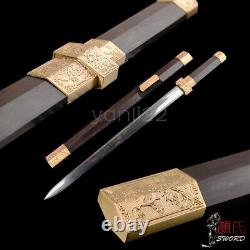
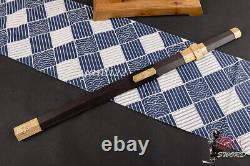
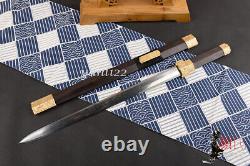
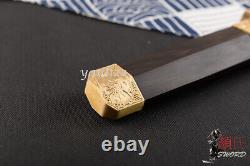
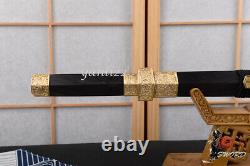
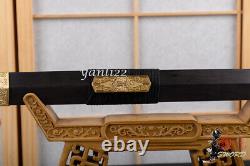
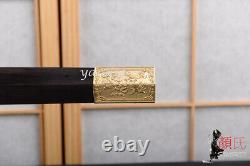
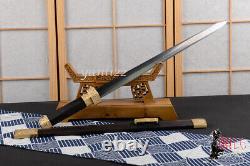
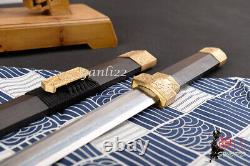
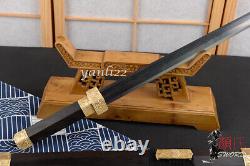
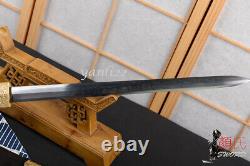
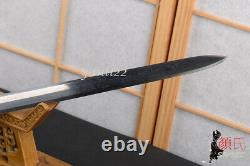

Gentleman Jian Chinese Sword Brass Fittings Ebony Handle Scabbard Sharp Blade. Blade Material: 1060 carbon steel. Forging Craft: folded forged by 11 times. Overall Length: 80.5 cm / 31.7'. Handle Length: 18 cm / 7.
Blade Length: 54 cm / 21.2. Width: 4.0 cm / 1.5. Sword Weight (with Scabbard): 1386 g. Weight Without Scabbard: 936 g. Is a double-edged straight sword used during the last 2,500 years in China.
The first Chinese sources that mention the jian date to the 7th century BCE during the Spring and Autumn period; one of the earliest specimens being the Sword of Goujian. Historical one-handed versions have blades varying from 45 to 80 centimeters (18 to 31 inches) in length.
The weight of an average sword of 70-centimetre (28-inch) blade-length would be in a range of approximately 700 to 900 grams (1.5 to 2 pounds). There are also larger two-handed versions used for training by many styles of Chinese martial arts. Professional jian practitioners are referred to as jianke?? "Sword guests" or "swordsmen"; a term dating from the Han dynasty.In Chinese folklore, it is known as "The Gentleman of Weapons" and is considered one of the four major weapons, along with the Gun (staff), Qiang (spear), and the Dao (sabre). This means that the carbon steel is folded by 11 times to produce 2048 layers.
The higher quantity of layers provides more unique and mystical hada patterns, which defines and displays the craftsman's experience and knowledge of traditional metallurgy passed down from generation to generation. Only the utmost skilled bladesmiths (Toushyo) and polishers (Togi-shi) can bring out the beauty and life from the Shinsakuto live blade.
During the forging process, all of the slags and impurities of the steel are burned off and folded forged to an uncompromised strength with an sharp cutting edge. The final carbon content is 1% and the hardness is an impressive HRC 55°on the Rockwell Scale. This high quality blade can easily cut through tatami straw mats or bamboo for Tameshigiri or Batto-do use.
HOW TO DISASSEMBLE A JP SWORD. For engraving English words, Chinese characters and Japanese Kanji. For engraving patterns dragon, lion, etc. Swords can be shaped by a variety of metalworking techniques. The primary techniques are forging and stock removal. Forging uses heat to bring the material to a malleable state. The material is then hammered to shape, typically using hammer and anvil together with specialized set and fuller tools depending on the particular technique. Stock removal shapes the sword from prepared stock that is larger in all dimensions than the finished sword by filing, grinding and cutting. After the blade has been shaped, the sword would be quenched. We quench our swords in either water or oil. Water quenching produces a tougher edge which can also be hardened further more using clay.Blades quenched in oil are still considerably hardened and do have superior flexibility compared to a water quenched blade. The more rapidly a blade cools down, the harder it becomes. Thus, when a hot blade enters the water, the water also gains heat and the blade will cool more gradually. Therefore, the first part of the blade that enters the water will be the hardest.
Therefore, the technique of quenching was also very important. If a blade has any flaws from forging (air bubbles, ash), it will break immediately during the quenching process. After quenching, the sword will be quite tough and brittle, with little flexibility.
To overcome this, the blade would undergo a tempering process. The blade would be reheated to a certain temperature degree then allowed to cool naturally. The blade would be slightly less tough afterward but have a greater degree of flexibility - the art would be to perfectly balance the blade for toughness, sharpness and flexibility. Finishing encompasses polishing, decorating, and crafting and assembling the hilt, guard and sheath.
The swordsmith would be most concerned with the state of the blade itself and possibly decorating the blade and preparing the guards and pommel. Other artisans would likely be involved in the work of fashioning the hilt, sheath and other furniture; and in any fine decoration. When the rough blade is completed, the swordsmith turns the blade over to a polisher, whose job it is to refine the shape of a blade and improve its aesthetic value. The polishing process almost always takes longer than even crafting, and a good polish can greatly improve the beauty of a blade, while a bad one can ruin the best of blades. Early polishers used three types of stone, whereas a modern polisher generally uses seven.
On high quality blades, only the back of the blade and the adjacent sides, are polished to a mirror-like surface. To bring out the grain and hamon, the center portion of the blade, and the edge are usually given a matte finish. Microscopic scratches in the surface vary, depending on hardness. Smaller but more numerous scratches in the harder areas reflect light differently from the deeper, longer scratches in the softer areas.
The harder metal appears more matte than the softer, and the manner in which it scatters light is less affected by the direction of the lighting. After the blade is finished it is passed on to a mountings-maker for fashioning the hilt, sheath and other mountings. International Buyers - Please Note. This item is in the category "Collectibles\Knives, Swords & Blades\Swords & Sabers\Asian\Chinese". The seller is "yanli22" and is located in this country: CN. This item can be shipped worldwide.- Type: Jian
- Blade Material: Damascus Steel
- Edge: Double, Straight
- Handle Material: Wood
- Color: Black
- Handedness: Double-Handed
- Brand: SJ SHI JIAN
- Original/Reproduction: Original
- Country/Region of Manufacture: China
- Style: Chinese
- Dexterity: Ambidextrous

